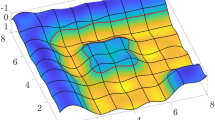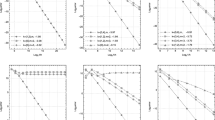Abstract
Laplacian- and optimization-based mesh-improvement methods are developed for high-order finite- and spectral-element based on 2D quadrilateral and 3D hexahedral meshes in general domains. A robust high-order interpolation library is used during the mesh smoothing process to improve the quality of the surface mesh while retaining the integrity of the original surface approximation. Boundary layer resolution in the original mesh is preserved through various controls in the smoothing process, including weighted interpolation between the optimized and original mesh. All mesh motion and gradient evaluations are performed on an element-by-element basis to ensure that all elements in a large mesh can be smoothed in parallel with minimum communication between different processors. Mesh quality improvements are shown to reduce the condition number of the preconditioned linear systems governing the numerical solution of the discretized partial differential equations, with corresponding reductions in iteration counts. The mesh smoother is tested on various meshes and is found to significantly improve the computational efficiency of calculations.














Similar content being viewed by others
Notes
The actual vertex count can vary from \((N-1)^3\) to \((N+1)^3\) per element, depending on boundary conditions and domain connectivity. Throughout the text, we will use the simpler expression of \(N^3\) unless otherwise noted.
References
Branets, L., Carey, G.F.: Extension of a mesh quality metric for elements with a curved boundary edge or surface. J. Comput. Inf. Sci. Eng. 5(4), 302–308 (2005)
Canann, S.A., Stephenson, M.B., Blacker, T.: Optismoothing: an optimization-driven approach to mesh smoothing. Finite Elem. Anal. Design 13(2–3), 185–190 (1993)
Canann, S.A., Tristano, J.R., Staten, M.L., Drive, T.: An approach to combined laplacian and optimization-based smoothing for triangular, quadrilateral, and quad-dominant meshes. In: IMR, pp. 479–494. Citeseer (1998)
Canuto, C., Gervasio, P., Quarteroni, A.: Finite-element preconditioning of G-NI spectral methods. SIAM J. Sci. Comput. 31(6), 4422–4451 (2010)
Canuto, C., Hussaini, M.Y., Quarteroni, A., Thomas Jr., A.: Spectral Methods in Fluid Dynamics. Springer, Berlin (2012)
Deville, M.O., Fischer, P.F., Mund, E.H.: High-Order Methods for Incompressible Fluid Flow, vol. 9. Cambridge University Press, Cambridge (2002)
Dey, S., Obara, R.M., Shephard, M.S.: Curvilinear mesh generation in 3D. In: IMR, pp. 407–417 (1999)
Dey, S., Shephard, M.S., Flaherty, J.E.: Geometry representation issues associated with p-version finite element computations. Comput. Methods Appl. Mech. Eng. 150(1–4), 39–55 (1997)
Dobrev, V.A., Kolev, T.V., Rieben, R.N.: High-order curvilinear finite element methods for lagrangian hydrodynamics. SIAM J. Sci. Comput. 34(5), B606–B641 (2012)
Erickson, J.: Theoretical advances in hexahedral mesh generation. http://jeffe.cs.illinois.edu/pubs/talks/hexmesh-survey-socg.pdf. Accessed 29 Aug 2016
Fischer, P., Schmitt, M., Tomboulides, A.: Recent developments in spectral element simulations of moving-domain problems. Recent Progress and Modern Challenges in Applied Mathematics, Modeling and Computational Science, pp. 213–244. Springer, New York (2017)
Fischer, P.F.: An overlapping Schwarz method for spectral element solution of the incompressible Navier–Stokes equations. J. Comput. Phys. 133(1), 84–101 (1997)
Fischer, P.F.: Scaling limits for PDE-based simulation. In: 22nd AIAA Computational Fluid Dynamics Conference, p. 3049 (2015)
Fischer, P.F., Lottes, J.W.: Hybrid Schwarz-multigrid methods for the spectral element method: extensions to Navier-Stokes. In: Barth, T.J., et al. (eds.) Domain Decomposition Methods in Science and Engineering, pp. 35–49. Springer, Berlin (2005)
Fischer, P.F., Tufo, H.M., Miller, N.I., Tufo, H.M.: An overlapping Schwarz method for spectral element simulation of three-dimensional incompressible flows. In: Bjørstad, P., Luskin, M. (eds.) Parallel Solution of Partial Differential Equations, pp. 159–180. Springer, Berlin (2000)
Freitag, L., Jones, M., Plassmann, P.: A parallel algorithm for mesh smoothing. SIAM J. Sci. Comput. 20(6), 2023–2040 (1999)
Freitag, L.A.: On combining Laplacian and optimization-based mesh smoothing techniques. ASME Appl. Mech. Divi. Publ. AMD 220, 37–44 (1997)
Freitag, L.A., Knupp, P.M.: Tetrahedral mesh improvement via optimization of the element condition number. Int. J. Numer. Methods Eng. 53(6), 1377–1391 (2002)
Freitag, L.A., Plassmann, P.: Local optimization-based simplicial mesh untangling and improvement. Int. J. Numer. Methods Eng. 49(1), 109–125 (2000)
Gargallo-Peiró, A., Roca, X., Peraire, J., Sarrate, J.: Defining quality measures for validation and generation of high-order tetrahedral meshes. In: Proceedings of the 22nd International Meshing Roundtable, pp. 109–126. Springer (2014)
Gordon, W.J., Hall, C.A.: Transfinite element methods: blending-function interpolation over arbitrary curved element domains. Numer. Math. 21(2), 109–129 (1973)
Gorman, G.J., Southern, J., Farrell, P.E., Piggott, M., Rokos, G., Kelly, P.H.: Hybrid OpenMP/MPI anisotropic mesh smoothing. Procedia Comput. Sci. 9, 1513–1522 (2012)
Heath, M.T.: Scientific Computing. McGraw-Hill, New York (2002)
Hesthaven, J.S., Gottlieb, S., Gottlieb, D.: Spectral Methods for Time-Dependent Problems, vol. 21. Cambridge University Press, Cambridge (2007)
Jansen, K.E., Shephard, M.S., Beall, M.W.: On anisotropic mesh generation and quality control in complex flow problems. In: IMR (2001)
Knupp, P.: Introducing the target-matrix paradigm for mesh optimization via node-movement. Eng. Comput. 28(4), 419–429 (2012)
Knupp, P.M.: Hexahedral mesh untangling & algebraic mesh quality metrics. In: IMR, pp. 173–183. Citeseer (2000)
Knupp, P.M.: A method for hexahedral mesh shape optimization. Int. J. Numer. Methods Eng. 332(November 2002), 319–332 (2003). https://doi.org/10.1002/nme.768
Kreiss, H.O., Oliger, J.: Comparison of accurate methods for the integration of hyperbolic equations. Tellus 24(3), 199–215 (1972). https://doi.org/10.1111/j.2153-3490.1972.tb01547.x
Lottes, J.W., Fischer, P.F.: Hybrid multigrid/Schwarz algorithms for the spectral element method. J. Sci. Comput. 24(1), 45–78 (2005)
Luo, X., Shephard, M.S., Remacle, J.F.: The influence of geometric approximation on the accuracy of high order methods. Rensselaer SCOREC Report, vol. 1 (2001)
Luo, X.J., Shephard, M.S., Obara, R.M., Nastasia, R., Beall, M.W.: Automatic p-version mesh generation for curved domains. Eng. Comput. 20(3), 273–285 (2004)
Lynch, R.E., Rice, J.R., Thomas, D.H.: Direct solution of partial difference equations by tensor product methods. Numer. Math. 6(1), 185–199 (1964)
Maday, Y., Patera, A.T.: Spectral element methods for the incompressible Navier–Stokes equations. In: IN: State-of-the-Art Surveys on Computational Mechanics (A90-47176 21-64). New York, American Society of Mechanical Engineers, 1989, p. 71–143. Research Supported by DARPA., vol. 1, pp. 71–143 (1989)
Maday, Y., Patera, A.T., Rønquist, E.M.: An operator-integration-factor splitting method for time-dependent problems: application to incompressible fluid flow. J. Sci. Comput. 5(4), 263–292 (1990)
Merzari, E., Heisey, K., Fischer, P.: Nek deep dive. https://cesar.mcs.anl.gov/sites/cesar.mcs.anl.gov/files/nekbone_0_1_1.pdf. Accessed 16 July 2017
Noguchi, S., Takada, A., Nobuyama, F., Miwa, M., Igarashi, H.: A new mesh smoothing method to improve the condition number of submatrices of coefficient matrix in edge finite element method. IEEE Trans. Magn. 49(5), 1705–1708 (2013)
Orszag, S.A.: Spectral methods for problems in complex geometries. J. Comput. Phys. 37(1), 70–92 (1980)
Patera, A.T.: A spectral element method for fluid dynamics: laminar flow in a channel expansion. J. Comput. Phys. 54(3), 468–488 (1984)
Perot, J.B.: An analysis of the fractional step method. J. Comput. Phys. 108(1), 51–58 (1993)
Salem, A., Saigal, S., Canann, S.A.: Mid-node admissible space for 3D quadratic tetrahedral finite elements. Eng. Comput. 17(1), 39–54 (2001)
Sherwin, S., Peiró, J.: Mesh generation in curvilinear domains using high-order elements. Int. J. Numer. Methods Eng. 53(1), 207–223 (2002)
Sherwin, S.J., Warburton, T.C., Karniadakis, G.E.: Spectral/hp methods for elliptic problems on hybrid grids. Contemp. Math. 218, 191–216 (1998)
Shewchuk, J.: What is a good linear finite element? interpolation, conditioning, anisotropy, and quality measures (preprint). Univ. Calif. Berkeley 73, 12 (2002)
Taubin, G.: Linear anisotropic mesh filtering. Research and Report RC2213 IBM , vol. 1(4) (2001)
Tufo, H.M., Fischer, P.F.: Fast parallel direct solvers for coarse grid problems. J. Parallel Distrib. Comput. 61(2), 151–177 (2001)
Warburton, T., Lomtev, I., Du, Y., Sherwin, S., Karniadakis, G.: Galerkin and discontinuous galerkin spectral/hp methods. Comput. Methods Appl. Mech. Eng. 175(3–4), 343–359 (1999)
Acknowledgements
The authors would like to thank Patrick Knupp for helpful discussions. This material is based upon work supported in part by the U.S. Department of Energy, Office of Science, Office of Advanced Scientific Computing Research, under Contract DE-AC02-06CH11357, and in part by the Exascale Computing Project (17-SC-20-SC), a collaborative effort of two U.S. Department of Energy organizations (Office of Science and the National Nuclear Security Administration) responsible for the planning and preparation of a capable exascale ecosystem, including software, applications, hardware, advanced system engineering, and early testbed platforms, in support of the nation’s exascale computing imperative. The research also used resources of the Argonne Leadership Computing Facility, which is supported by the U.S. Department of Energy, Office of Science, under Contract DE-AC02-06CH11357, and from the Blue Waters sustained-petascale computing Project, which is supported by the National Science Foundation (Awards OCI-0725070 and ACI-1238993) and the state of Illinois.
Author information
Authors and Affiliations
Corresponding author
Rights and permissions
About this article
Cite this article
Mittal, K., Fischer, P. Mesh Smoothing for the Spectral Element Method. J Sci Comput 78, 1152–1173 (2019). https://doi.org/10.1007/s10915-018-0812-9
Received:
Revised:
Accepted:
Published:
Issue Date:
DOI: https://doi.org/10.1007/s10915-018-0812-9




